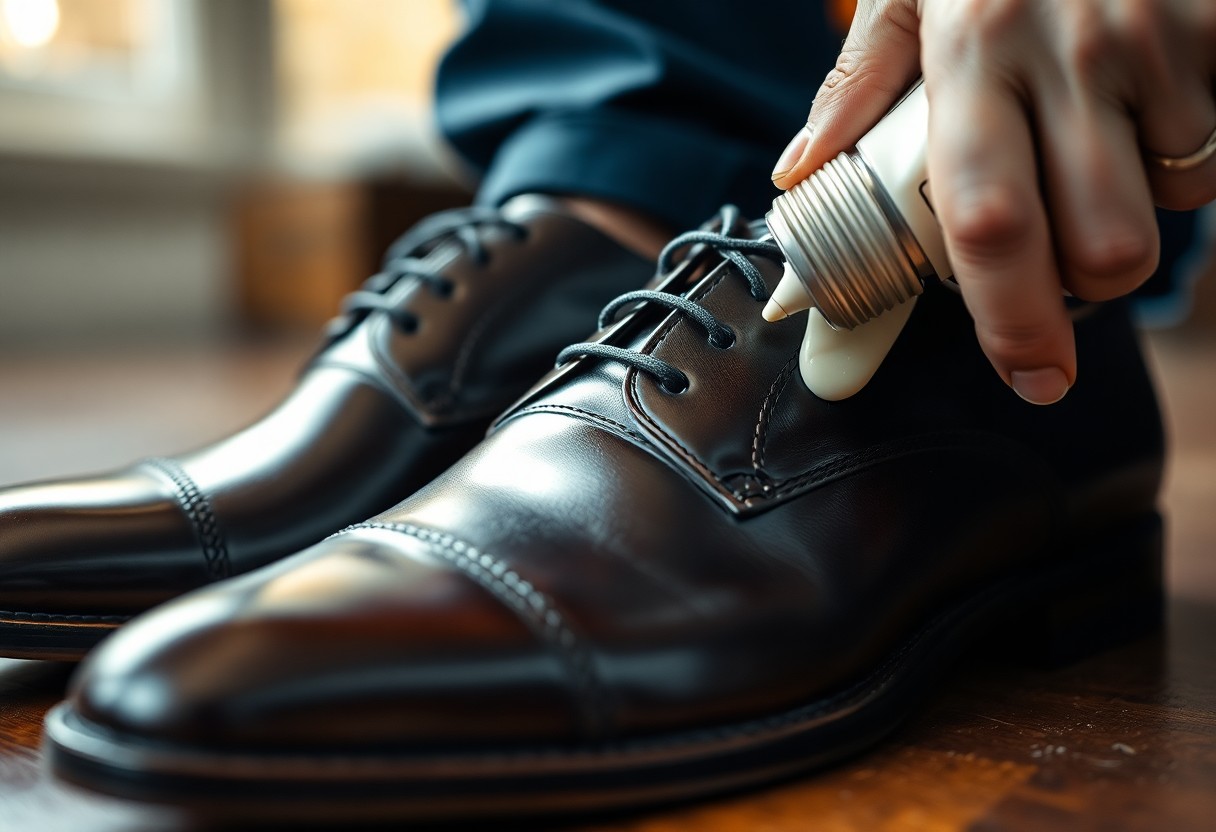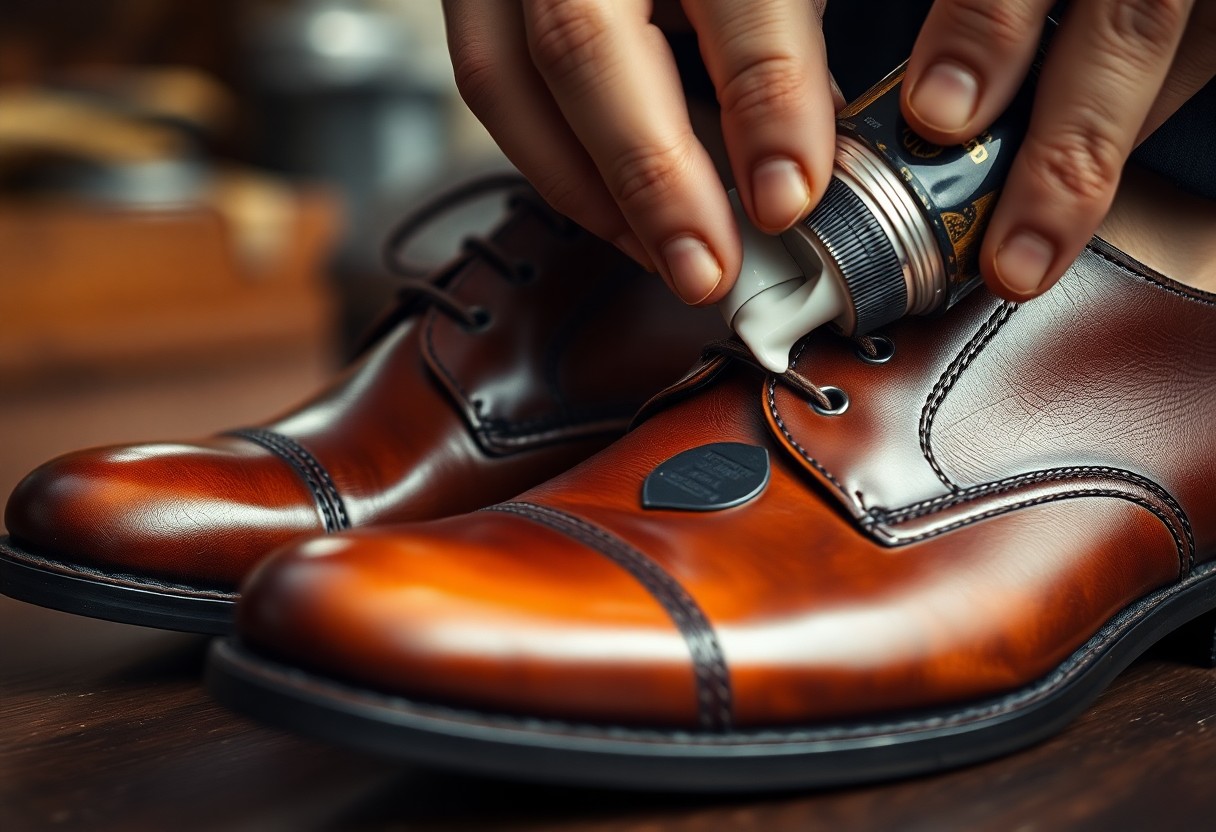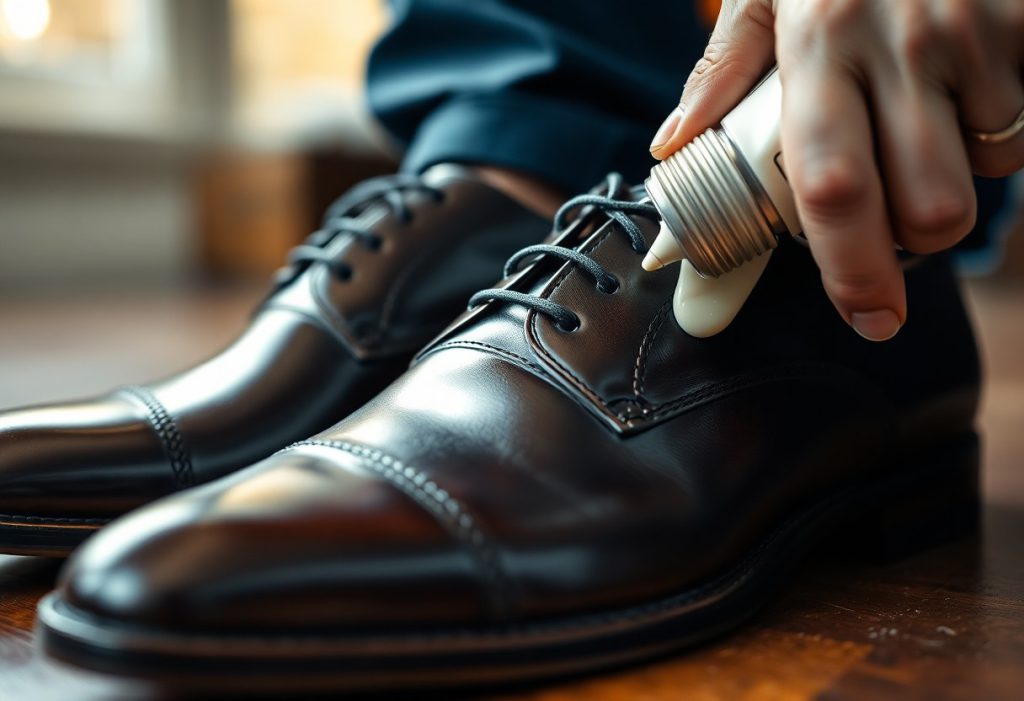Transforming your leather shoes with darker shoe cream can dramatically enhance their overall look, elevating them to a new level of elegance and style. By applying several thin layers of cream in increasingly darker shades, you can replicate results that rival professional craftsmanship. It’s essential to begin with a cream that closely matches your shoe’s original color to avoid any uneven tones. For the best outcome, choose premium pigmented creams from trusted brands like Saphir Medaille d’Or or Boot Black. This technique is particularly effective for lighter-colored shoes, where you can achieve impressive transformations while maintaining a natural finish.
Effective Strategies for Elevating Your Shoe Color
Enhancing the color of your shoes successfully demands a well-organized environment and high-quality materials. Start by creating a clean and well-lit workspace, allowing ample time for applying multiple layers of cream. It’s imperative that your shoes are thoroughly cleaned and completely dry before you start the enhancement process. This preparatory step is essential for achieving a smooth and lasting finish that will endure over time, ensuring your shoes look their best.
Essential Equipment for Applying Shoe Cream Like a Pro
To avert any mishaps during your shoe color enhancement adventure, gather these essential tools: application brushes, polishing cloths, and masking tape to safeguard the soles. Additionally, make sure you have high-pigment shoe creams from reputable sources like Saphir Medaille d’Or or Boot Black on hand. Don’t forget to prepare your cleaning supplies and a quality leather cleaner to effectively ready your shoes for the cream application.
Selecting the Perfect Cream Colors for Stunning Results
As you embark on your color enhancement journey, it’s critical to choose shoe creams that will gradually build up to your desired shade. Aim to start with a cream color that closely resembles your shoe’s original hue before moving on to darker shades. This step-by-step process is especially important for lighter-colored shoes, helping to avoid any uneven coloring that could detract from the overall appeal.
Your choice of tools and cream will greatly impact your final results. Your cream selection should include a base color that matches the original shoe shade, along with 2-3 progressively darker shades for layering. Utilizing high-quality pigmented creams from distinguished brands like Saphir, Boot Black, or Collonil 1909 will guarantee optimal color enhancement. When working with light-colored shoes, you have the opportunity for a more dramatic darkening effect, while darker shoes will need more subtle adjustments to maintain a refined look.
Applying Color Theory to Achieve Professional Results in Shoe Coloring
Grasping how colors interact is vital for achieving a polished finish when darkening your shoes. A solid understanding of color theory can help you avoid common mistakes, such as uneven application or poor shade choices. By utilizing the color wheel, you can gain insights into the relationships between colors like browns, blacks, and burgundies, enabling you to better predict how different shoe creams will impact the final appearance of your leather footwear.
Systematic Progression from Lighter to Darker Shades
One of the most critical principles in shoe coloring is to incrementally progress from lighter to darker shades. The success of this technique hinges on making small, measured changes. For instance, a light brown shoe can evolve into a medium brown and then onto dark brown, but reversing this order is not recommended. Each additional layer of cream should be slightly darker than the previous one, ensuring optimal results.
Comprehending Color Depth for Superior Results
Darker shoe creams possess higher concentrations of pigment, which allows them to significantly alter the appearance of your shoes. Always conduct a test on a small, inconspicuous area before applying cream to the entire shoe. Quality creams such as Saphir Medaille d’Or or Boot Black offer superior color control and consistency, enhancing your satisfaction with the end result.
The success of your color enhancement largely depends on the techniques you utilize while layering. Applying multiple thin layers leads to better results than a single thick coat. Begin with 2-3 layers of a lighter shade before advancing to darker tones. This method guarantees even coverage and minimizes the risk of patchy or blotchy results that could detract from the overall visual appeal of your shoes.
Essential Pre-Treatment Procedures for Optimal Shoe Cream Application
Before you begin applying darker shoe cream, it’s crucial to adhere to a specific sequence of preparatory steps. Ensure your shoes are completely dry and at room temperature for the best cream absorption. This preparation stage includes removing any old polish, thoroughly cleaning the leather surface, and safeguarding areas that you want to keep uncolored. Following these initial steps will help prevent uneven coloring and lead to results that exceed your expectations.
Thorough Cleaning Techniques for Leather Shoe Surfaces
Start by performing a comprehensive cleaning of your shoes. Utilize a leather cleaner to remove all dirt, old polish, and oils. Your cleaning method should be gentle yet thorough, paying special attention to creases and seams where residue tends to gather. A perfectly clean surface allows the shoe cream to penetrate evenly, which is crucial for achieving a flawless finish that enhances the beauty of your footwear.
Professional Masking Techniques for Protecting Shoes During Color Enhancement
Properly masking your shoes is essential for achieving professional results. You need to protect the sole edges, welts, and any contrasting stitching with masking tape. This precaution will prevent unwanted staining and help maintain the original appearance of these elements, ensuring that your efforts result in a polished outcome.
Effective surface protection involves carefully applying masking tape along the edges where the upper part of the shoe meets the sole. Be sure to cover any decorative features or light-colored stitching that you wish to preserve. Based on my experiences with Midas boots and TLB Mallorca Artista shoes, adequate masking can save hours of cleanup and yield professional, clean results that you can take pride in.
Step-by-Step Process for Successfully Darkening Shoes
To achieve outstanding results when darkening your shoes, it’s vital to follow a methodical approach. This process involves gradually building color using premium pigmented shoe creams. Light-colored shoes are generally easier to darken, but they demand careful attention to detail to avoid any uneven coloring. Your success greatly relies on the tools you use and the application of multiple thin layers rather than a single thick coat.
Establishing a Solid Base Layer for Effective Color Enhancement
This step marks the foundation of your color enhancement efforts. Begin with a shoe cream shade that closely matches your shoe’s original color. Use an application brush to treat the edges and a polishing cloth for the main areas. Always protect the sole edges and stitching with masking tape to avoid any unwanted staining. Your initial layer acts as a primer for the deeper colors that follow, ensuring each subsequent layer adheres effectively.
Creating Depth of Color through Layering Techniques
As you continue to apply multiple layers, gradually introduce darker shades. Focus on applying thin, even layers using high-pigment creams such as Saphir Medaille d’Or or Boot Black. Apply 2-3 layers of each shade before transitioning to a darker tone. This approach guarantees that your shoes develop a rich, uniform coloring that enhances their overall elegance.
Further enhancement is contingent upon your technique and patience. The ultimate results will be determined by how well you work the cream into the leather. Employ circular motions with your cloth to ensure even distribution. Allow each layer to dry thoroughly before applying the next. This meticulous approach can transform light brown shoes into deeper tans or enrich burgundy tones.

Mastering the Multi-Layer Method for Exceptional Color Enhancement
Not all color enhancement projects need to be completed in a single session. Your success depends on patience and gradual application. This method involves applying multiple thin layers of shoe cream, starting with lighter shades and progressively moving to darker ones, ensuring an even and professional finish that reflects your dedication and skill.
Beginning with Lighter Initial Layers for Best Results
The multi-layer application process kicks off with a shade that closely matches your shoe’s original color. Refrain from starting with dark cream immediately, as this may lead to spotting and uneven coloring. Apply 2-3 thin layers of light-colored cream, allowing each layer to dry for about 15 minutes before applying the next. This careful approach will lay the groundwork for a beautifully darkened shoe.
Integrating Darker Layers for Enhanced Visual Depth
After establishing your light base, you can gradually introduce darker cream layers. Choose high-quality pigmented creams like Saphir Medaille d’Or or Boot Black for the best results. Apply the cream using gentle circular motions to ensure complete coverage while avoiding excess product buildup that can detract from the overall finish.
For optimal outcomes, focus on hard-to-reach areas near the sole edges. Always conduct a test on a small, hidden area first to avoid any unwanted color reactions. Continue layering until you achieve your desired shade, which typically involves 3-4 applications of the darker cream to reach the ideal tone.

Important Considerations for Successful Shoe Color Enhancement
Unlike standard shoe care, enhancing color necessitates careful consideration of leather characteristics and proper product selection. Understanding your shoe’s base color, leather type, and the desired outcome is crucial before embarking on the darkening process. The effectiveness of your color enhancement is heavily reliant on your technique and patience in applying multiple thin layers for the best results.
Recognizing the Differences Among Various Leather Types
Different leather types react differently to color enhancement:
| Leather Type | Color Enhancement Characteristics |
|---|---|
| Full-grain | Best absorption, uniform results |
| Top-grain | Good absorption; requires careful application |
| Suede | Not recommended for cream treatment |
| Patent | Cannot absorb cream effectively |
| Corrected-grain | Limited absorption; uneven results possible |
Identifying and Managing Common Problem Areas During Application
Common issues frequently arise near seams, creases, and toe areas. It’s imperative to apply cream with extra care in these regions to prevent excess color buildup. Recognizing potential problem spots before you start will assist in avoiding uneven coloring, ensuring a smoother application process.
At the beginning of your color enhancement project, test the cream on a small, hidden area to evaluate its effects before proceeding. Your meticulous attention to detail in these sensitive zones will significantly impact the final quality of your shoe’s appearance. Pay special attention to the welt area, where excess cream can easily accumulate and create uneven patches.
- Apply lighter coats to creases to avoid heavy buildup
- Avoid excess product near stitching to maintain integrity
- Utilize masking tape to protect the soles from accidental staining
- Work in small sections for the best results and control
Common Questions About Shoe Color Enhancement Answered
What is the best way to start darkening light-colored shoes with shoe cream?
Begin by selecting a shoe cream color that is closest to your shoe’s original shade. Apply several thin layers using premium shoe cream brands like Saphir Medaille d’Or or Boot Black. Be sure to cover the sole edges and stitching with masking tape to protect them during the process. Add 2-3 layers of the lighter shade before transitioning to darker colors for optimal results.
Which tools are recommended for applying shoe cream during the color enhancement process?
Use an application brush for reaching difficult areas near the sole edges, and a polishing cloth for the main surfaces to help distribute the cream evenly into the leather. These tools allow for complete coverage and a smooth application across all shoe areas, contributing to a more polished finish.
What techniques can I use to ensure an even color result when darkening shoes?
To achieve a uniform finish, apply multiple thin layers instead of one thick layer. Start with a lighter shade and gradually move to darker shades. Use gentle, circular motions with your cloth to work the cream into the leather, allowing each layer to dry completely before applying the next. This approach effectively prevents spotting and creates a smooth, consistent finish that enhances the overall appearance of your shoes.
The Article How to enhance shoe color using darker shoe cream tips for a polished look appeared first on My Shoes Finder
The Article Enhance Shoe Color with Darker Shoe Cream Tips for a Polished Look Was Found On https://limitsofstrategy.com
The Article Darker Shoe Cream Tips for a Polished Shoe Colour Enhancement First Appeared ON
: https://ad4sc.com



I love the idea of using different layers of darker shoe cream to elevate the look of leather shoes! It’s such a game changer, especially for those lighter-colored pairs that can often feel bland after a while. I recently tried this technique on an old pair of tan loafers, and the transformation was pretty impressive. It felt like I brought them back to life!
Using darker layers of shoe cream really is a fantastic idea, isn’t it? It’s like giving those leather shoes a little spa day—who knew an old pair of loafers had such glamorous potential hidden under all that wear and tear? Your experience sounds like a redemption story worthy of a Hollywood script: “The Loafer Chronicles: A Tan to Triumph Saga.”
I’m so glad to hear that! If you’re looking to elevate your leather care routine even further, check out this guide that dives deeper into techniques and products for a stunning finish. Happy polishing!
https://oldicom.net/webilaro
The process of transforming leather shoes through pigment application is fascinating, and it underscores a broader narrative about the care and craftsmanship surrounding footwear. I appreciate how you highlighted the importance of using thin layers of darker cream, as this technique not only ensures a gradual transition in color but also allows individuals to maintain a certain level of control over the final outcome. It’s a process that seems to echo the artisanal traditions found in many crafts, where attention to detail and patience can yield results that rival those of professionals.
Your insights on transforming leather shoes with darker shoe cream are certainly intriguing and resonate with my experience in shoe care. I’ve found that the process of layering creams not only enhances the aesthetic appeal but also extends the life of the shoes.